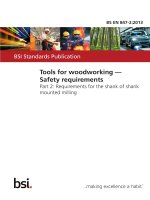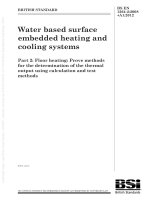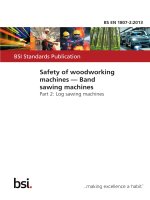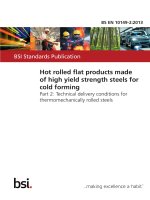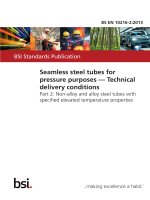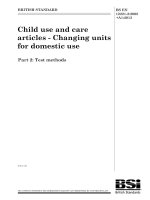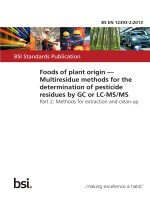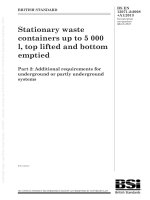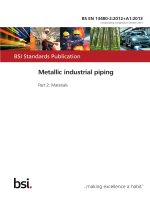Bsi bs en 61010 2 201 2013
Bạn đang xem bản rút gọn của tài liệu. Xem và tải ngay bản đầy đủ của tài liệu tại đây (2.1 MB, 60 trang )
BS EN 61010-2-201:2013
BSI Standards Publication
Safety requirements for
electrical equipment for
measurement, control,
and laboratory use
Part 2-201: Particular requirements
for control equipment
BRITISH STANDARD
BS EN 61010-2-201:2013
National foreword
This British Standard is the UK implementation of EN 61010-2-201:2013,
incorporating corrigendum September 2013. It is identical to
IEC 61010-2-201:2013.
Corrigendum September 2013 changes the supersession wording on the
CEN title page and in the CEN foreword.
The UK participation in its preparation was entrusted to Technical
Committee GEL/65, Measurement and control.
A list of organizations represented on this committee can be obtained on
request to its secretary.
This publication does not purport to include all the necessary provisions of
a contract. Users are responsible for its correct application.
© The British Standards Institution 2013
Published by BSI Standards Limited 2013
ISBN 978 0 580 83876 7
ICS 13.110; 17.020; 19.020; 25.040.40
Compliance with a British Standard cannot confer immunity from
legal obligations.
This British Standard was published under the authority of the
Standards Policy and Strategy Committee on 30 November
2013.
Amendments/corrigenda issued since publication
Date
Text affected
EN 61010-2-201
EUROPEAN STANDARD
NORME EUROPÉENNE
EUROPÄISCHE NORM
May 2013
ICS 13.110; 17.020; 19.020; 25.040.40
Incorporating corrigendum September 2013
English version
Safety requirements for electrical equipment for measurement, control
and laboratory use Part 2-201: Particular requirements for control equipment
(IEC 61010-2-201:2013)
Règles de sécurité pour appareils
électriques de mesurage, de régulation et
de laboratoire Partie 2-201: Exigences particulières pour
les équipements de commande
(CEI 61010-2-201:2013)
Sicherheitsbestimmungen für elektrische
Mess-, Steuer-, Regel- und Laborgeräte Teil 2-201: Besondere Anforderungen für
Steuer- und Regelgeräte
(IEC 61010-2-201:2013)
This European Standard was approved by CENELEC on 2013-04-01. CENELEC members are bound to comply
with the CEN/CENELEC Internal Regulations which stipulate the conditions for giving this European Standard
the status of a national standard without any alteration.
Up-to-date lists and bibliographical references concerning such national standards may be obtained on
application to the CEN-CENELEC Management Centre or to any CENELEC member.
This European Standard exists in three official versions (English, French, German). A version in any other
language made by translation under the responsibility of a CENELEC member into its own language and notified
to the CEN-CENELEC Management Centre has the same status as the official versions.
CENELEC members are the national electrotechnical committees of Austria, Belgium, Bulgaria, Croatia, Cyprus,
the Czech Republic, Denmark, Estonia, Finland, Former Yugoslav Republic of Macedonia, France, Germany,
Greece, Hungary, Iceland, Ireland, Italy, Latvia, Lithuania, Luxembourg, Malta, the Netherlands, Norway, Poland,
Portugal, Romania, Slovakia, Slovenia, Spain, Sweden, Switzerland, Turkey and the United Kingdom.
CENELEC
European Committee for Electrotechnical Standardization
Comité Européen de Normalisation Electrotechnique
Europäisches Komitee für Elektrotechnische Normung
Management Centre: Avenue Marnix 17, B - 1000 Brussels
© 2013 CENELEC -
All rights of exploitation in any form and by any means reserved worldwide for CENELEC members.
Ref. No. EN 61010-2-201:2013 E
BS EN 61010-2-201:2013
EN 61010-2-201:2013
-2-
Foreword
The text of document 65/515/FDIS, future edition 1 of IEC 61010-2-201, prepared by IEC TC 65
"Industrial-process measurement, control and automation" was submitted to the IEC-CENELEC parallel
vote and approved by CENELEC as EN 61010-2-201:2013.
The following dates are fixed:
•
•
latest date by which the document has
to be implemented at national level by
publication of an identical national
standard or by endorsement
latest date by which the national
standards conflicting with the
document have to be withdrawn
(dop)
2014-01-01
(dow)
2016-04-01
This Part 2-201 is intended to be used in conjunction with EN 61010-1:2010. Consideration may be given
to future editions of, or amendments to, EN 61010-1.
This Part 2-201 supplements or modifies the corresponding clauses in EN 61010-1 so as to convert that
publication into the European standard: Particular requirements for control equipment.
Where a particular subclause of Part 1 is not mentioned in this part 2, that subclause applies as far as is
reasonable. Where this part states “addition”, “modification”, “replacement”, or “deletion”, the relevant
requirement, test specification or note in Part 1 should be adapted accordingly.
Attention is drawn to the possibility that some of the elements of this document may be the subject of
patent rights. CENELEC [and/or CEN] shall not be held responsible for identifying any or all such patent
rights.
This standard covers the Principle Elements of the Safety Objectives for Electrical Equipment Designed
for Use within Certain Voltage Limits (LVD - 2006/95/EC).
Endorsement notice
The text of the International Standard IEC 61010-2-201:2013 was approved by CENELEC as a European
Standard without any modification.
In the official version, for Bibliography, the following notes have to be added for the standards indicated:
IEC 60079 series
NOTE Harmonised in EN 60079 series.
IEC 60364 series
NOTE Harmonised in HD 60364 series.
IEC 60364-4-41
NOTE Harmonised as HD 60364-4-41.
IEC 60664-5:2007
NOTE Harmonised as EN 60664-5:2007 (not modified).
IEC 60715:1981 +
A1:1995
NOTE Harmonised as EN 60715:2001 (not modified).
IEC 60721-2-3:1987
NOTE Harmonised as HD 478.2.3 S1:1990 (not modified).
IEC 61131-2:2007
NOTE Harmonised as EN 61131-2:2007 (not modified).
IEC 61131-6:2012
NOTE Harmonised as EN 61131-6:2012 (not modified).
IEC 61140:2001
NOTE Harmonised as EN 61140:2002 (not modified).
IEC 61326 series
NOTE Harmonised in EN 61326 series.
-3-
IEC 61508 series
NOTE Harmonised in EN 61508 series.
IEC 61643 series
NOTE Harmonised in EN 61643 series.
IEC 61643-21
NOTE Harmonised as EN 61643-21.
IEC 61643-311
NOTE Harmonised as EN 61643-311.
IEC 61643-321
NOTE Harmonised as EN 61643-321.
IEC 61643-331
NOTE Harmonised as EN 61643-331.
IEC 61800 series
NOTE Harmonised in EN 61800 series.
IEC 62133:2002
NOTE Harmonised as EN 62133:2003 (not modified).
IEC 62368 series
NOTE Harmonised in EN 62368 series.
BS EN 61010-2-201:2013
EN 61010-2-201:2013
BS EN 61010-2-201:2013
EN 61010-2-201:2013
-4-
Annex ZA
(normative)
Normative references to international publications
with their corresponding European publications
The following documents, in whole or in part, are normatively referenced in this document and are
indispensable for its application. For dated references, only the edition cited applies. For undated
references, the latest edition of the referenced document (including any amendments) applies.
NOTE When an international publication has been modified by common modifications, indicated by (mod), the relevant EN/HD
applies.
Addition to Annex ZA of EN 61010-1:2010:
Publication
Year
Title
EN/HD
Year
IEC 60068-2-31
2008
Environmental testing Part 2-31: Tests - Test Ec: Rough handling
shocks, primarily for equipment-type
specimens
EN 60068-2-31
2008
IEC 60384-14
2005
Fixed capacitors for use in electronic
equipment Part 14: Sectional specification - Fixed
capacitors for electromagnetic interference
suppression and connection to the supply
mains
EN 60384-14
2005
IEC 60664-1
2007
Insulation coordination for equipment within
low-voltage systems Part 1: Principles, requirements and tests
EN 60664-1
2007
IEC 60695-2-11
+ corr. January
2000
2001
Fire hazard testing EN 60695-2-11
Part 2-11: Glowing/hot-wire based test
methods - Glow-wire flammability test method
for end-products
2001
IEC 60947-5-1
2003
Low-voltage switchgear and controlgear EN 60947-5-1
Part 5-1: Control circuit devices and switching + corr. July
elements - Electromechanical control circuit
devices
2004
2005
IEC 60947-7-1
2009
Low-voltage switchgear and controlgear Part 7-1: Ancillary equipment - Terminal
blocks for copper conductors
2009
IEC 61010-1
+ corr. May
2010
2011
Safety requirements for electrical equipment EN 61010-1
for measurement, control and laboratory use Part 1: General requirements
2010
IEC 61010-2-030
-
Safety requirements for electrical equipment EN 61010-2-030
for measurement, control and laboratory use Part 2-030: Particular requirements for testing
and measuring circuits
-
IEC 61051-2
1991
Varistors for use in electronic equipment Part 2: Sectional specification for surge
suppression varistors
-
EN 60947-7-1
-
–2–
BS EN 61010-2-201:2013
61010-2-201 © IEC:2013
CONTENTS
INTRODUCTION ..................................................................................................................... 7
1
Scope and object .............................................................................................................. 8
2
1.1.1 Equipment included in scope ....................................................................... 8
1.1.2 Equipment excluded from scope .................................................................. 9
1.2.1 Aspects included in scope ........................................................................... 9
1.2.2 Aspects excluded from scope ...................................................................... 9
Normative references ..................................................................................................... 10
3
Terms and definitions ..................................................................................................... 10
4
Tests .............................................................................................................................. 12
4.1
5
General ................................................................................................................. 12
4.3.2 State of equipment .................................................................................... 12
4.4 Testing in single fault condition ............................................................................. 12
Marking and documentation ............................................................................................ 14
6
5.4.3 Equipment installation ............................................................................... 14
Protection against electric shock .................................................................................... 14
7
6.1.2 Exceptions ................................................................................................. 14
6.2.1 General ..................................................................................................... 14
6.2.2 Examination .............................................................................................. 14
6.2.3 Openings above parts that are hazardous live ........................................... 14
6.2.4 Openings for pre-set controls .................................................................... 15
6.2.101 Accessibility of interfaces/ports/terminals .................................................. 15
6.2.102 Control equipment ..................................................................................... 17
6.6.1 General ..................................................................................................... 20
6.6.2 Terminals for external circuits .................................................................... 20
6.6.3 Circuits with terminals which are hazardous live ........................................ 20
6.6.4 Terminals for stranded conductors ............................................................. 20
6.7.2 Insulation for mains circuits of overvoltage category II with a nominal
supply voltage up to 300 V ........................................................................ 22
6.7.3 Insulation for secondary circuits derived from mains circuits of
overvoltage category II up to 300 V ........................................................... 24
6.7.101 Insulation for field wiring terminals of overvoltage category II with a
nominal voltage up to 1 000 V ................................................................... 26
6.8.3 Test procedures ........................................................................................ 26
6.10 Connection to the mains supply source and connections between parts of
equipment ............................................................................................................. 26
6.11 Disconnection from supply source ......................................................................... 27
Protection against mechanical hazards ........................................................................... 27
8
7.1.101 Open and panel mounted equipment ......................................................... 27
7.2 Sharp edges .......................................................................................................... 27
7.3.3 Risk assessment for mechanical hazards to body parts ............................. 27
7.3.4 Limitation of force and pressure................................................................. 28
7.3.5 Gap limitations between moving parts ....................................................... 28
7.7 Expelled parts ....................................................................................................... 28
Resistance to mechanical stresses ................................................................................. 28
8.1.101 Open equipment ........................................................................................ 28
BS EN 61010-2-201:2013
61010-2-201 © IEC:2013
9
–3–
8.1.102 Panel mounted equipment ......................................................................... 28
8.2.2 Impact test ................................................................................................ 28
8.3 Drop test ............................................................................................................... 28
8.3.1 Equipment other than hand-held equipment and direct plug-in
equipment ................................................................................................. 29
8.3.2 Hand-held equipment and direct plug-in equipment ................................... 29
Protection against the spread of fire ............................................................................... 29
9.2
Eliminating or reducing the sources of ignition within the equipment ...................... 29
9.3.2 Constructional requirements ...................................................................... 29
10 Equipment temperature limits and resistance to heat ...................................................... 30
10.1 Surface temperature limits for protection against burns ......................................... 30
10.3 Other temperature measurements ......................................................................... 31
10.4.1 General ..................................................................................................... 31
10.4.2 Temperature measurement of heating equipment ...................................... 32
10.4.3 Equipment intended for installation in a cabinet or a wall ........................... 32
10.5.2 Non-metallic enclosures ............................................................................ 33
11 Protection against hazards from fluids ............................................................................ 33
11.6 Specially protected equipment ............................................................................... 33
12 Protection against radiation, including laser sources, and against sonic and
ultrasonic pressure ......................................................................................................... 33
13 Protection against liberated gases and substances, explosion and implosion ................. 34
13.1 Poisonous and injurious gases and substances ..................................................... 34
13.2.1 Components .............................................................................................. 34
13.2.2 Batteries and battery charging ................................................................... 34
14 Components and subassemblies .................................................................................... 34
14.101
Components bridging insulation ..................................................................... 34
14.101.1
Capacitors ......................................................................................... 34
14.101.2
Surge surpressors ............................................................................. 34
14.102
Switching devices .......................................................................................... 35
15 Protection by interlocks .................................................................................................. 35
16 Hazards resulting from application .................................................................................. 35
17 Risk assessment ............................................................................................................ 35
Annexes ............................................................................................................................... 35
Annex F (normative) Routine tests ....................................................................................... 36
Annex L (informative) Index of defined terms ....................................................................... 38
Annex AA (informative) General approach to safety for control equipment ........................... 39
Annex BB (informative) System drawing of isolation boundaries .......................................... 41
Annex CC (informative) Historical techniques for secondary circuits .................................... 49
Annex DD (informative) Cross references between IEC 61010-2-201 and IEC 610101:2010 or IEC 61131-2:2007 ................................................................................................. 53
Bibliography .......................................................................................................................... 54
Figure 101 – Typical interface/port diagram of control equipment.......................................... 16
Figure 102 – Requirements for insulation between separate circuits and between
circuits and accessible conductive parts ............................................................................... 21
Figure 103 – Mechanical hazards requirements for panel mounted equipment ...................... 27
Figure 104 – Safety enclosure with HMI installed through a wall ........................................... 30
–4–
BS EN 61010-2-201:2013
61010-2-201 © IEC:2013
Figure 105 – Panel mounted HMI device extending through the wall of a cabinet .................. 33
Figure AA.1 – Control equipment access and safety concerns .............................................. 39
Figure BB.1 – Typical system enclosure layout ..................................................................... 42
Figure BB.2 – Simplified system schematic ........................................................................... 43
Figure BB.3 – Hazard situation of the control equipment ....................................................... 44
Figure BB.4 – Application of the standard to the control equipment safety drawing ............... 45
Figure BB.5 – Reinforced insulation ...................................................................................... 46
Figure BB.6 – Basic insulation .............................................................................................. 47
Figure BB.7 – Reinforced insulation, basic insulation and limiting impedance ....................... 48
Table 101 – Overload test circuit values ............................................................................... 13
Table 102 – Endurance test circuit values ............................................................................. 13
Table 103 – Operator accessibility for open and enclosed equipment ................................... 16
Table 4 – Clearance and creepage distances for mains circuits of overvoltage category
II up to 300 V ........................................................................................................................ 23
Table 5 – Test voltages for solid insulation between mains and between mains and
secondary circuits overvoltage category II up to 300 V d ....................................................... 24
Table 6 – Clearances and test voltages for secondary circuits derived from mains
circuits of overvoltage category II up to 300 V ....................................................................... 25
Table 104 – Minimum creepages and clearances in air of overvoltage category II up to
1 000 V at field-wiring terminals ............................................................................................ 26
Table 105 – Drop tests .......................................................................................................... 29
Table 19 – Surface temperature limits, under normal conditions ........................................... 31
Table CC.1 – Limits of output current and output power for inherently limited power
sources ................................................................................................................................. 51
Table CC.2 – Limits of output current, output power and ratings for over-current
protective devices for non-inherently limited power sources .................................................. 52
Table DD.1 – Cross-references between IEC 61010-2-201 and IEC 61010-1 or
IEC 61131-2 ......................................................................................................................... 53
BS EN 61010-2-201:2013
61010-2-201 © IEC:2013
–7–
INTRODUCTION
This IEC 61010-2-201 document constitutes Part 2-201 of a planned series of standards on
industrial-process measurement, control and automation equipment.
This part specifies the complete safety requirements for control equipment (e.g.
programmable controller (PLC)), the components of Distributed Control Systems, I/O devices,
Human Machine Interface (HMI)).
Safety terms of general use are defined in IEC 61010-1. More specific terms are defined in
each part.
This part incorporates the safety related requirements of Programmable Controllers.
Annex DD provides a cross reference between clauses of this standard and those of
IEC 61010-1 or IEC 61131-2:2007.
–8–
BS EN 61010-2-201:2013
61010-2-201 © IEC:2013
SAFETY REQUIREMENTS FOR ELECTRICAL EQUIPMENT
FOR MEASUREMENT, CONTROL, AND LABORATORY USE –
Part 2-201: Particular requirements for control equipment
1
Scope and object
This clause of Part 1 is applicable, except as follows.
1.1.1
Equipment included in scope
Replacement:
This part of IEC 61010 specifies safety requirements and related verification tests for control
equipment of the following types:
–
Programmable controllers (PLC and PAC);
–
the components of Distributed Control Systems (DCS);
–
the components of remote I/O – systems;
–
industrial PC (computers) and Programming and Debugging Tools (PADTs);
–
Human-Machine Interfaces (HMI);
–
any product performing the function of control equipment and/or their associated
peripherals,
which have as their intended use the control and command of machines, automated
manufacturing and industrial processes, e.g. discrete and continuous control.
Components of the above named equipment and in the scope of this standard are:
–
(auxiliary) stand-alone power supplies;
–
peripherals such as digital and analogue I/O, remote-I/O;
–
industrial network equipment.
Control equipment and their associated peripherals are intended to be used in an industrial
environment and may be provided as open or enclosed equipment.
NOTE 1 Control equipment intended also for use in other environments or for other purposes (example; for use in
building installations to control light or other electrical installations, or for use on cars, trains or ships) can have
additional conformity requirements defined by the safety standard(s) for these applications. These requirements
can involve as example: insulation, spacings and power restrictions.
NOTE 2 Computing devices and similar equipment within the scope of IEC 60950 (planned to be replaced by
IEC 62368) and conforming to its requirements are considered to be suitable for use with control equipment within
the scope of this standard. However, some of the requirements of IEC 60950 for resistance to moisture and liquids
are less stringent than those in IEC 61010-1:2010, 5.4.4 second paragraph.
Control equipment covered in this standard is intended for use in overvoltage category II
(IEC 60664-1) in low-voltage installations, where the rated equipment supply voltage does not
exceed a.c. 1 000 V r.m.s. (50/60 Hz), or d.c. 1 500 V.
NOTE 3 If equipment in the scope of this part is applied to overvoltage category III and IV installations, then the
requirements of Annex K of Part 1 apply.
The requirements of ISO/IEC Guide 51 and IEC Guide 104, as they relate to this Part, are
incorporated herein.
BS EN 61010-2-201:2013
61010-2-201 © IEC:2013
1.1.2
–9–
Equipment excluded from scope
Replacement:
This standard does not deal with aspects of the overall automated system, e.g. a complete
assembly line. Control equipment (e.g. DCS and PLC), their application program and their
associated peripherals are considered as components (components in this context are items
which perform no useful function by themselves) of an overall automated system.
Since control equipment (e.g. DCS and PLC) are component devices, safety considerations
for the overall automated system including installation and application are beyond the scope
of this standard. Refer to IEC 60364 series of standards or applicable national/local
regulations for electrical installation and guidelines.
1.2.1
Aspects included in scope
Replacement:
The purpose of the requirements of this standard is to ensure that all hazards to the operator,
service personnel and the surrounding area are reduced to a tolerable level.
NOTE By using the terms "operator" and "service personnel" this standard considers the perception of hazards
depending on training and skills. Annex AA gives a general approach in this regard.
Requirements for protection against particular types of hazard are given in Clauses 6 to 13,
as follows:
a) electric shock or burn (see Clause 6);
b) mechanical hazards (see Clauses 7 and 8);
c) spread of fire from the control equipment (see Clause 9);
d) excessive temperature (see Clause 10);
e) effects of fluids and fluid pressure (see Clause 11);
f)
effects of radiation, including lasers sources, and sonic and ultrasonic pressure (see
Clause 12);
g) liberated gases, explosion and implosion (see Clause 13);
Requirements for protection against hazards arising from reasonably foreseeable misuse and
ergonomic factors are specified in Clause 16.
Risk assessment for hazards or environments not fully covered above is specified in Clause
17.
NOTE Attention is drawn to the existence of additional requirements regarding the health and safety of labour
forces.
1.2.2
Aspects excluded from scope
Replacement:
This standard does not cover:
a) reliability, functionality, performance, or other properties of the control equipment not
related to safety;
b) mechanical or climatic requirements for operation, transport or storage;
c) EMC requirements (See e.g. IEC 61326 or IEC 61131-2);
d) protective measures for explosive atmospheres (See e.g. IEC 60079 series);
e) functional safety (See e.g. IEC 61508 or IEC 61131-6).
– 10 –
2
BS EN 61010-2-201:2013
61010-2-201 © IEC:2013
Normative references
This clause of Part 1 is applicable, except as follows:
Addition of the following references to the list:
IEC 60068-2-31:2008, Environmental testing – Part 2-31: Tests – Test Ec: Rough handling
shocks, primarily for equipment-type specimens
IEC 60384-14:2005, Fixed capacitors for use in electronic equipment – Part 14: Sectional
specification: Fixed capacitors for electromagnetic interference suppression and connection to
the supply mains
IEC 60664-1:2007, Insulation coordination for equipment within low-voltage systems – Part 1:
Principles, requirements and tests
IEC 60695-2-11:2000, Fire hazard testing – Part 2-11: Glowing/hot-wire based test methods –
Glow-wire flammability test method for end-products
IEC 60947-5-1:2003, Low-voltage switchgear and controlgear – Part 5-1: Control circuit
devices and switching elements – Electromechanical control circuit devices
IEC 60947-7-1:2009, Low-voltage switchgear and controlgear – Part 7-1: Ancillary equipment
– Terminal blocks for copper conductors
IEC 61010-1:2010, Safety requirements for electrical equipment for measurement, control,
and laboratory use – Part 1: General requirements
IEC 61010-2-030, Safety requirements for electrical equipment for measurement, control, and
laboratory use – Part 2-030: Particular requirements for testing and measuring circuits
IEC 61051-2:1991, Varistors for use in electronic equipment – Part 2: Sectional specification
for surge suppression varistors
3
Terms and definitions
This clause of Part 1 is applicable, except as follows:
Additional terms and definitions:
3.101
enclosed equipment
equipment which includes an enclosure, having safety capability, or combination of an
enclosure, having safety capability, and installation provisions enclosing on all sides, with the
possible exception of its mounting surface, to prevent personnel from accidentally touching
hazardous live, hot or moving parts contained therein and meeting requirements of
mechanical strength, flammability, and stability (where applicable)
Note 1 to entry:
Examples are portable and hand-held equipment.
Note 2 to entry:
This definition is related to IEC 60050-441:1990, 441-12-02.
3.102
enclosure
housing affording the type and degree of protection suitable for the intended application
BS EN 61010-2-201:2013
61010-2-201 © IEC:2013
– 11 –
[SOURCE: IEC 60050-195:1998, 195-02-35]
Note 1 to entry: An enclosure, in general, may or may not have any safety capabilities. That depends on its
application purpose and construction.
Note 2 to entry:
otherwise.
In this standard an enclosure is assumed to have safety capability, unless specifically stated
3.103
field wiring
wiring of the control equipment, which is installed by the user
Note 1 to entry:
Examples of field wiring are power supply, digital and analogue input and output wiring.
3.104
hand-held equipment
equipment which is intended to be held in one hand while being operated with the other hand
3.105
modular equipment
equipment consisting of different modules such as a Rack, CPU, different I/O-modules,
network modules etc.
Note 1 to entry:
Modular equipment
a)
can be open equipment or enclosed equipment,
b)
can consist of modules that cannot operate alone or of a basic module that is operational alone and can be
enhanced in functions by additional modules,
c)
can vary in size and functionality depending on the combination and the number of modules and
d)
can be combined with operational equipment or enhanced in function by the addition of modules by the
customer.
3.106
open equipment
equipment which does not protect personnel from accidentally touching live or moving parts
contained therein nor meet requirements of mechanical strength, flammability and stability
(where applicable)
Note 1 to entry:
See Annex AA.
3.107
operator
person, with appropriate training and awareness of the general hazards in an industrial
environment, commanding and monitoring, but not changing, a machine or process
Note 1 to entry: The operator does not change e.g. the control equipment hardware configuration or install
software updates provided by the manufacturer.
Note 2 to entry:
the equipment.
The operator commands and monitors a machine or process e.g. through an HMI connected to
3.108
portable equipment
equipment intended to be carried by hand and not fixed during normal use
3.109
protective extra-low voltage circuit
PELV circuit
electrical circuit in which the voltage cannot exceed a.c. 30 V r.m.s., 42,4 V peak or d.c. 60 V
in normal and single-fault condition, except earth faults in other circuits
Note 1 to entry: A PELV circuit incorporates a connection to protective earth. Without the protective earth
connection or if there is a fault in the protective earth connection the circuit voltages are not controlled.
– 12 –
Note 2 to entry:
BS EN 61010-2-201:2013
61010-2-201 © IEC:2013
Derived from IEC 60050-826:2004, 826-12-32, PELV system
3.110
safety extra-low voltage circuit
SELV circuit
electrical circuit in which the voltage cannot exceed a.c. 30 V r.m.s., 42,4 V peak or d.c. 60 V
in normal and single-fault condition, including earth faults in other circuits
Note 1 to entry:
Derived from IEC 60050-826:2004, 826-12-31, SELV system.
3.111
service personnel
person, with the appropriate technical training, experience and awareness of hazards and of
measures to minimize danger to themselves, other persons or to the control equipment, in an
industrial environment, changing or repairing the control equipment
Note 1 to entry: Service personnel are persons having the appropriate technical training and experiences
necessary to be aware of hazards – e.g, electrical hazards, temperature hazards, fire hazards – to which they are
exposed in performing a task and of measures to minimize danger to themselves or to other persons or to the
control equipment, in an industrial environment
Note 2 to entry: Service personnel change or repair the control equipment e.g. hardware configuration or
installing software updates provided by the manufacturer.
4
Tests
This clause of Part 1 is applicable, except as follows.
4.1
General
Addition:
The product is verified to this standard in a test configuration, defined by the manufacturer,
which represents the least favourable configuration. See 4.3.
It is likely or possible that there are different test configurations which yield least favourable
test conditions, e.g. a least favourable configuration for temperature tests, a least favourable
test configuration for electrical safety test. If this is the case then these different least
favourable test configuration(s) shall be used in the test for which they are appropriate, with
regard to 4.3.2 and 4.4.
These least favourable test configurations and test conditions shall be practical and useful for
the intended applications.
Conformity verification: The selected test configuration(s) and test conditions shall be
documented with the rationale in the test report
4.3.2
State of equipment
Addition:
The state of the control equipment shall take into account the least favourable rated
environmental conditions. This may be taken into account by the actual test environment of
the control equipment or by suitable analysis and correction of the results in a set of reference
test conditions.
4.4
Testing in single fault condition
Addition of first line after 4.4:
BS EN 61010-2-201:2013
61010-2-201 © IEC:2013
– 13 –
For test and verification conditions, see 4.1.
Additional subclause:
4.4.1.101
4.4.1.101.1
Switching devices tests
Overload test
Switching devices shall close and open a test circuit having the current, voltage, and power
factor values given in Table 101. Fifty cycles, each consisting of 1 closing and 1 opening,
shall be completed using a timing of 1 s on, 9 s off. After completion of the 50 cycles, the
equipment shall be subjected to the endurance test in 4.4.1.101.2, if required by 14.102.
Table 101 – Overload test circuit values
Intended use
Current
Voltage
Power factor
AC general use
1,5 × rated
Rated
0,75 to 0,80
DC general use
1,5 × rated
Rated
1,0
AC resistance
1,5 × rated
Rated
1,0
DC resistance
1,5 × rated
Rated
AC pilot duty
a
DC pilot duty
a
1,0
Rated
a
1,1 × rated
Rated
a
1,1 × rated b
b
<0,35
1,0
a
Unless otherwise specified, the inrush current shall be 10 times the steady-state current.\
b
Set up the EUT at its rated voltage and current and then increase the voltage by 10 % without further
adjustment of the load.
NOTE
Source IEC 61131-2:2007
Conformity, pass/fail, is determined by test completion without electrical/dielectric/mechanical
breakdown of the equipment.
4.4.1.101.2
Endurance test
After completion of the overload test in 4.4.1.101.1, the switching device is to close and open
a test circuit having the current, voltage, and power factor values given in Table 102. A total
of 6 000 cycles, consisting of 1 closing and 1 opening, shall be completed. The cycle timing
shall be 1 s on and 9 s off, except for the first 1 000 cycles of the pilot duty test. The first
1 000 cycles of the pilot duty test shall be at a rate of 1 cycle per second except that the first
10 to 12 cycles are to be as fast as possible.
The endurance test need not be conducted on solid-state output devices for general or
resistive use.
Table 102 – Endurance test circuit values
a
Intended use
Current
Voltage
Power factor
AC general use
Rated
Rated
0,75 to 0,80
DC general use
Rated
Rated
1,0
AC resistance
Rated
Rated
1,0
DC resistance
Rated
Rated
1,0
AC pilot duty
a
Rated
Rated
<0,35
DC pilot duty
a
Rated
Rated
1,0
The test circuit is identical to the overload test circuit except that the voltage is the rated voltage.
NOTE
Source IEC 61131-2:2007
– 14 –
BS EN 61010-2-201:2013
61010-2-201 © IEC:2013
Conformity, pass/fail, is determined by test completion without electrical/dielectric/mechanical
breakdown of the equipment.
5
Marking and documentation
This clause of Part 1 is applicable, except as follows.
5.4.3
Equipment installation
Addition:
h) open equipment: If the control equipment is classified as open equipment its
documentation shall specify the final safety enclosure characteristics, e.g. safety enclosure
mechanical rigidity, IP rating.
Replacement of item d)1):
d) 1): supply and field wiring requirements, e.g. insulation, temperature rating
6
Protection against electric shock
This clause of Part 1 is applicable, except as follows.
6.1.2
Exceptions
Replacement:
If it is not feasible for operating reasons to prevent the following parts being both accessible
and hazardous live, they are permitted to be accessible to a service personnel during normal
use while they are hazardous live:
For example:
a) parts of lamps and lamp sockets after lamp removal;
b) parts intended to be replaced by an service personnel (for example, batteries) and which
may be hazardous live during the replacement or other service personnel action, but only
if they are accessible only by means of a tool and have a warning marking (see 5.2);
If any of the parts in examples a) and b) receive a charge from an internal capacitor, they
shall not be hazardous live 10 s after interruption of the supply.
If a charge is received from an internal capacitor, conformity is checked by the measurements
of 6.3 to establish that the levels of 6.3.1 c) are not exceeded.
6.2.1
General
This subclause of Part 1 is applicable to enclosed equipment.
6.2.2
Examination
This subclause of Part 1 is applicable to enclosed equipment.
6.2.3
Openings above parts that are hazardous live
This subclause of Part 1 is applicable to enclosed equipment.
BS EN 61010-2-201:2013
61010-2-201 © IEC:2013
6.2.4
– 15 –
Openings for pre-set controls
Addition:
First paragraph: This subclause of Part 1 is applicable to enclosed equipment. This subclause
applies to service personnel.
Additional subclauses:
6.2.101 Accessibility of interfaces/ports/terminals
Peripherals
(permanently /
non-permanently installed)
Ar
Al
Remote IOs
C
J
Local extension rack
C
J
Input
Processing
unit(s)
and
Memory
E
E
F
F
K
K
G
Output
Module(s)
Communicati
ons Modules
(optional)
Power supply
Auxiliary power
supply (optional)
D
J
D
J
H
G
Interface/port digital and analogue input signals
I/O power interface/port
D
J
Interface/port digital and analogue output signals
I/O power interface/port
E
Communication interface/port with third- party
devices (e.g. computers, printers)\
D
J
C
J
Module(s)
Basic
Control
Equipment
C
J
E
F
F
Equipment power interface/port
K
Auxiliary power output interface/port
used to power sensors and actuators
G
K
H
G
Be
H
Bi
Protective earthing port
Functional earthing port
Open communication interface/port,
also open to third-party devices
Be
Bi
Be
H
Bi
Be
Bi
Internal communication interface/port
for peripherals
Limit of the scope of this standard
Interfaced devices and signals
IEC 148/13
Key
Al
Communication interface/port for local extension rack
Ar
Communication interface/port for remote I/O station, control network, fieldbus
Be
Open communication interface/port, also open to third-party devices; e.g. PADT, personal computer used for
programming
Bi
Internal communication interface/port for peripherals
BS EN 61010-2-201:2013
61010-2-201 © IEC:2013
– 16 –
C
Interface/port for digital and analogue input signals
D
Interface/port for digital and analogue output signals
E
Serial or parallel communication interfaces/ports for data communication with third-party devices; e.g.
computers, printers
F
Equipment power interface/port. Devices with F ports have requirements on keeping downstream devices
intelligent during power up, power down and power interruptions.
G
Protective earthing port
H
Functional earthing port
J
I/O power interface/port
K
Auxiliary power output interface/port used to power sensors and actuators
Figure 101 – Typical interface/port diagram of control equipment
Table Table 103 defines whether ports of control equipment are operator accessible, and thus
require protection against electric shock. Other than for Ports Ar, Be and E, protection can be
achieved by making the live parts within the port inaccessible as determined by 6.2.
Table 103 – Operator accessibility for open and enclosed equipment
Port
Open equipment
Enclosed equipment
Al communication interface/port for local extension rack
No
Yes
Ar communication interface/port for remote IO station, control network,
fieldbus a
Yes
Yes
Be open communication interface/port, also open to third-party devices;
e.g. PADT, personal computer used for programming a
Yes
Yes
Bi internal communication interface/port for peripherals
No
Not applicable b
C interface/port for digital and analogue input signals
No
Yes
D interface/port for digital and analogue output signals
No
Yes
E serial or parallel communication interfaces/ports for data communication
with third-party devices; e.g. computers and printers a
Yes
Yes
F equipment power interface/port
No
Yes
G protective earthing port
No
Yes
H functional earthing port
No
Yes
J I/O power interface/port
No
Yes
K auxiliary power output interface/port used to power sensors and
actuators
No
Yes
a
Ports Ar, Be and E contain circuits which may be connected to other equipment and shall be considered accessible.
b
Port Bi is an internal communication port and thus never leaves the enclosed equipment, by definition.
Under special circumstances, some ports of either open or enclosed equipment may or may
not be considered operator accessible. This shall be agreed upon between the manufacturer
and the user by instructions in the user manual.
Operator-accessible parts and the ports, as defined in Table 103, shall be prevented from
becoming hazardous live under normal and single-fault conditions.
Conformity is checked by inspection and in case of doubt by measurement and test according
to 6.2.
BS EN 61010-2-201:2013
61010-2-201 © IEC:2013
– 17 –
6.2.102 Control equipment
6.2.102.1 Accessible parts
Accessible parts of control equipment shall not be, or in the case of a single fault become,
hazardous live. Although they are principally directed at enclosed equipment, these
requirements also apply to open equipment. When applied to open equipment, the control
equipment shall be considered to be installed, according to the manufacturer’s instructions.
Also see 5.4.3 and Annex AA.
If service personnel are required to make adjustments, etc., during e.g. commissioning of
open equipment, then protection from hazards in the area near the adjustment shall be
provided to prevent contact. If the hazard is not indicated by a warning label (see 5.2) then
other means by e.g. safety enclosure or barrier is required.
Conformity is checked by inspection and examination according to 6.2.2.
6.2.102.2 SELV circuits
SELV circuits do not require additional evaluation for risk against electrical shock, provided
that those circuits are in dry locations.
6.5.2.3
Protective conductor terminal
Addition:
NOTE Protective earthing terminals and earthing contacts are not connected directly to the neutral terminal within
the system. This does not prevent the connection of appropriately rated devices (such as capacitors or surge
suppression devices) between the protective earthing terminal and neutral
6.5.2.5
Impedance of protective bonding of permanently connected equipment
Addition at the end of the subclause:
If no overcurrent protection means is specified in the control equipment installation manual
then, conformity is checked by applying a test current for 1 min and then calculating
impedance. The test current is the greater of:
a) 25 A d.c. or a.c. r.m.s. at rated mains frequency;
b) a current equal to twice the rated current of the control equipment.
6.5.2.6
Transformer protective bonding screen
Addition of the following second paragraph:
If the control equipment has no overcurrent protection means for the winding then the test
current shall be twice the rating of the control equipment overcurrent protection means (e.g.
fuse, circuit breaker). This overcurrent protection means may be integrated into the control
equipment either or specified in the manual.
Additional subclauses:
6.5.2.101 Classes of equipment or equipment classes
6.5.2.101.1
General
Equipment classes are described to designate the means by which electric shock protection is
maintained in normal condition and single-fault conditions of the installed equipment.
NOTE
Derived from IEC 61140:2001, Clause 7.
– 18 –
6.5.2.101.2
BS EN 61010-2-201:2013
61010-2-201 © IEC:2013
Class I equipment
Equipment in which protection against electric shock is achieved using basic insulation and
also providing a means of connecting the conductive parts, which are otherwise capable of
assuming hazardous voltages if the basic insulation fails, to the protective earth conductor.
NOTE Class I equipment can have parts with double insulation or reinforced insulation or parts operating at safety
extra-low voltage.
If a flexible cord is utilized, it shall include a provision for a protective earth conductor that
shall be part of the cord set.
Accessible conductive parts of equipment, which may become hazardous live in the event of a
single fault, shall be connected to the protective circuit of the equipment. Conductive parts,
such as screws, rivets and nameplates, which can become hazardous live under single-fault
conditions, shall be protected by other means such as double/reinforced insulation so that
they do not become hazardous live.
When a part of the equipment is removed from the enclosure, for normal maintenance, for
example, the protective circuits serving other parts of the equipment shall not be interrupted.
Protective earthing requirements are specified in 6.5.2.102 or 6.5.2.103.
6.5.2.101.3
Class II equipment
Equipment in which protection against electric shock does not rely on basic insulation only,
but also on the provision of additional safety precautions, such as double insulation or
reinforced insulation. There is no provision for protective earthing or reliance upon installation
conditions.
A protective impedance may be used in lieu of double insulation.
A means for maintaining the continuity of circuits is acceptable (i.e. grounded internal
components or conductive surfaces) provided that these circuits are double insulated from the
accessible circuits of the equipment.
Connection to the earthing terminals for functional purposes is acceptable (such as
radiofrequency interference suppression) provided the double insulation system is still
provided for protective purposes.
Such equipment may be of one of the following types:
a) insulation-encased by a durable and substantially continuous enclosure of insulating
material which envelops all conductive parts, with the exception of small parts, such as
nameplates, screws and rivets, which are isolated from hazardous live parts by insulation
at least equivalent to reinforced insulation;
b) metal-encased by a substantially continuous metal enclosure, in which double insulation is
used throughout, except for those parts where reinforced insulation is used;
c) combination of a) and b).
NOTE 1 Insulation-encasement can form a part of the whole of the supplementary insulation or of the reinforced
insulation.
NOTE 2 Utilization of double insulation and/or reinforced insulation throughout, with a protective earthing terminal
or contact, is deemed to be of class I construction.
NOTE 3
This equipment may have parts operating at safety extra-low voltage.
BS EN 61010-2-201:2013
61010-2-201 © IEC:2013
6.5.2.101.4
– 19 –
Class III equipment
Equipment in which protection against electric shock is provided by circuits supplied by safety
extra-low voltage (SELV) and where voltages generated do not exceed the limits for SELV.
Connection to the earthing terminals for functional purposes is acceptable (such as
radiofrequency interference suppression).
Wiring for SELV/PELV circuits shall be either segregated from the wiring for circuits other
than SELV/PELV, or the insulation of all conductors shall be rated for the higher voltage.
Alternatively, earthed screening or additional insulation shall be arranged around the wiring
for SELV/PELV circuits or around the wiring of other circuits, based on IEC 60364-4-41.
6.5.2.102 Protective earthing requirements for enclosed equipment
The accessible parts of Class I equipment (for example, chassis, frame and fixed metal parts
of metal enclosures) other than those which cannot become hazardous shall be electrically
interconnected and connected to a protective earth terminal for connection to an external
protective conductor. This requirement can be met by structural parts providing adequate
electrical continuity and applies whether the equipment is used on its own or incorporated in
an assembly.
Cords or cables that supply power to Class I equipment portable equipment peripherals shall
be provided with a protective earthing conductor. See 6.5.2.2.
Accessible isolated conductive parts are considered not to constitute a danger if they are so
located as to exclude any contact with live parts and withstand the dielectric test voltage of
Table 5 for reinforced insulation, corresponding to the highest rated operational voltage of the
unit.
Class II equipment may have an internal functional earth bonding conductor but shall not be
provided with a protective earthing terminal or a protective earthing conductor in the
equipment power input cord.
If the equipment is provided with a protective earthing terminal (Class I equipment), the
following requirements also apply in addition to the previous general connection
specifications.
•
The protective earthing terminal shall be readily accessible and so placed that the
connection of the equipment to the protective earthing conductor is maintained when the
cover or any removable part is removed.
•
Products which are intended for mains cord connected use (such as equipment
peripherals) shall be provided with a protective earthing terminal integral to the plug cap
or socket (if removable cord set).
•
The protective earthing terminal shall be of screw, stud or pressure type and shall be
made of a suitable corrosion resistant material.
•
The clamping means of protective earthing terminals shall be adequately locked against
accidental loosening, and it shall not be possible to loosen them without the aid of a tool.
•
Protective earthing terminals and earthing contacts shall not be connected direct to the
neutral terminal within the equipment. This does not prevent the connection of
appropriately rated devices (such as capacitors or surge suppression devices) between
the protective earthing terminal and neutral.
•
The protective earthing terminal and subsequent protective equipment internal to the
equipment shall comply with the requirements in 6.5.2.4 or 6.5.2.5.
•
The protective earthing terminal shall have no other function.
– 20 –
BS EN 61010-2-201:2013
61010-2-201 © IEC:2013
6.5.2.103 Protective earthing requirements for open equipment
Open equipment shall comply with the requirements of 6.5.2.4 or 6.5.2.5 with the exception
that the provision for connection to an external protective conductor may be replaced by a
means for bonding to the enclosure accessible to the operator.
6.6.1
General
Replacement of Note 2 as follows:
NOTE 2 For cord connected mains supply see 6.10.
6.6.2
Terminals for external circuits
Addition at beginning of the subclause:
All parts of terminals that maintain contact and carry current shall be of metal of adequate
mechanical strength.
Conformity shall be checked in accordance with IEC 60947-7-1 or relevant IEC standard.
The mechanical design of the interfaces shall allow that no individual conductor is subjected
to bending of a radius of curvature less than six times its diameter after removal of the
common elements (armour, sheaths, fillers).
Conformity is checked by inspection.
Clearances between terminals and terminal to earthed parts are given in 6.7.101.
6.6.3
Circuits with terminals which are hazardous live
Replacement:
This applies to both terminals and ports (see Table 103).
For enclosed equipment no accessible conductive parts may be hazardous live. For open
equipment protection for those ports defined in Table 103 shall be provided.
Conformity is checked by inspection.
6.6.4
Terminals for stranded conductors
Replacement:
Any stranded conductor carrying hazardous live voltage shall be prevented from contacting
other conductive parts, by appropriate clearance and creepage distances.
Conformity is checked by measurement with a stranded conductor of 8 mm length or by
inspection.
NOTE
The use of wire-end sleeves (ferrules) with plastic collars avoids stranded conductors.
6.7.1.1
General
Addition after the first paragraph:
Insulation requirements between separate circuits and between circuits and accessible
conductive parts are specified in Figure 102.
BS EN 61010-2-201:2013
61010-2-201 © IEC:2013
– 21 –
B1
Mains Circuit
Mains Circuit
B1
HAZARDOUS VOLTAGE
SECONDARY CIRCUIT
HAZARDOUS VOLTAGE
SECONDARY CIRCUIT
B2
Operating at less than or equal to
mains voltage
Operating at less than or equal to
mains voltage
B1 or B21
B2
HAZARDOUS VOLTAGE
SECONDARY CIRCUIT
HAZARDOUS VOLTAGE
SECONDARY CIRCUIT
B2
Operating at greater than mains
voltage
Operating at greater than mains
voltage
B1
B2
B2
B2
Unaccessible ELV CIRCUIT
R1
R2
R2
R2
B3
Accessible SELV CIRCUIT
B3
Accessible PELV CIRCUIT
Accessible conductive parts
R1
R2
R2
R2
F
F
B1
B2
B2
B2
F
Accessible PELV CIRCUIT
F
(Unearthed)
Earthed conductive parts and
Accessible SELV CIRCUIT
B3
R2
R2
R2
R1
Unaccessible ELV CIRCUIT
F
accessible earthed parts
of PELV circuit
F
Accessible conductive parts
(Unearthed)
Earthed conductive parts and
accessible earthed parts
of PELV circuit
IEC 149/13
B1 - Basic level of protection shall meet the requirements of 6.4. Creepage, Clearances, and Solid Insulation shall
meet the requirements of 6.7.2.
B2 - Basic level of protection shall meet the requirements of 6.4. Creepage, Clearances, and Solid Insulation shall
meet the requirements of 6.7.3.
B3 - Basic level of protection shall meet the requirements of 6.4. Creepage, Clearances, and Solid Insulation shall
meet the requirements of 6.7.3. May be waived if fault testing per Clause 4 demonstrates no hazard occurs.
R1 - Supplementary/Reinforced level of protection shall meet the requirements of 6.5. Creepage, Clearances, and
Solid Insulation shall meet the requirements of 6.7.2.
R2 - Supplementary/Reinforced level of protection shall meet the requirements of 6.5. Creepage, Clearances, and
Solid Insulation shall meet the requirements of 6.7.3.
F - Functional insulation. No specific level specified.
Earthed conductive parts – Shall meet the requirements of 6.5.2.4 or 6.5.2.5.
Creepage and clearance requirements are based upon the maximum voltage involved.
1
The greater of B1 or B2 insulation, depending on the higher of the working voltages of the mains and secondary
circuits.
Figure 102 – Requirements for insulation between separate circuits
and between circuits and accessible conductive parts
Addition at the end of the subclause:
SELV/PELV circuits and ungrounded conductive accessible parts shall meet the insulation
requirements for double, reinforced insulation or basic insulation and ground between these
and hazardous live parts.
6.7.1.5
Requirements for insulation according to type of circuits
Replacement:
– 22 –
BS EN 61010-2-201:2013
61010-2-201 © IEC:2013
Requirements for insulation between separate circuits and between circuits and accessible
conductive parts are specified as follows:
a)
in Figure 102 or
b)
in IEC 61010-1:2010, K.3. for circuits that have one or more of the following
characteristics:
1)
the maximum possible transient overvoltage is limited by the supply source or within
the equipment to a known level below the level assumed for the mains circuit;
2)
the maximum possible transient overvoltage is above the level assumed for the
mains circuit;
3)
the working voltage is the sum of voltages from more than one circuit, or is a mixed
voltage;
4)
the working voltage includes a recurring peak voltage that may include a periodic
non-sinusoidal waveform or a non-periodic waveform that occurs with some
regularity;
5)
the working voltage has a frequency above 30 kHz;
Requirements for insulation of measuring circuits are specified in IEC 61010-2-030.
NOTE
See IEC 61010-1:2010, K.3 for requirements for switching circuits such as a switching power supply.
Additional subclauses:
6.7.1.101 Non-metallic material supporting hazardous live parts
Non-metallic material supporting hazardous live parts shall have a comparative tracking index
greater than, or equal to, 175.
6.7.1.102 Non-metallic barriers and related applications
Non-metallic material used to increase clearance and/or creepage distances (e.g. barriers)
but not relied upon to maintain the position of live parts (even if contacting live parts) shall
have a comparative tracking index greater than or equal to 100.
6.7.2
Insulation for mains circuits of overvoltage category II with a nominal supply
voltage up to 300 V
Modification:
For mains circuits above 300 V, see Annex K.
6.7.2.1
Clearances and creepage distances
Replacement of Table 4:

